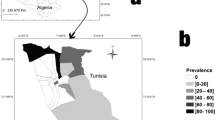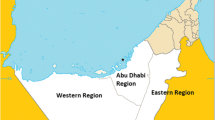Abstract
A case–control study was conducted in a rural area of Achaia in western Greece to examine the risk factors of brucellosis. The participants in the study were 414 (7.5% of the whole population of the investigated municipality). The cases (n = 140) were defined by clinical symptoms and confirmed by a positive standard agglutination test (SAT). All cases have been diagnosed between January 1997 and March 1999 either by physicians of the Local Health Center or by private practitioners. Two criteria were basic to establish the disease. The first one was clinical symptoms such as fever, fatigue, arthralgia and generalized aches and the second was a titer of SAT at least 1:160. Controls (n = 274) were matched with cases for age and gender in a 1:2 ratio. Approximately collection of controls was performed among those presented to the local Health Center for other diseases. Data were collected by the same physician via a personal interview and analyzed by logistic regression models. The overall incidence of the disease in the region was found to be 1110/100,000. Taking ‘no ownership of animals’ and ‘no contact of animals’ as the reference category, the strongest risk factor was trauma during animal delivery with an odds ratio (OR): 24.3; 95% confidence interval (CI): 8.8–67.5 following by absence of stables (OR: 14.4; 95% CI: 4.7–44.1). After application of multivariate stepwise analysis the adjusted risk factors remaining in the model were the place of residence (OR: 1.8; 95% CI: 1.1–3.1), professional occupation with animals (OR: 2.4; 95% CI: 1.2–4.8), absence of stables (OR: 9.1; 95% CI: 2.2–38.7) and trauma during animal delivery (OR: 11.2; 95% CI: 3.2–39.1). Consumption of cheese from pasteurized milk or consumption of cheese matured for over 3 months was found to be a protective factor (OR: 0.27; 95% CI: 0.11–0.67). The detection of brucellosis in animals is essential for the prevention of the disease. In addition efficient preventive measures should be established in order to eliminate the disease.
Similar content being viewed by others
References
Hall WH. Brucellosis. In: Evans AS, Brachman PS (eds), Bacterial Infections of Humans: Epidemiology and Control. New York and London: Plenum Medical Book Company, 1991; 133–149.
Mishal J, Ben-Israel N, Levin Y, et al. Brucellosis outbreak: Analysis of risk factors and serological screening. Int J Mol Med 1999; 9: 655–658.
Corbel MJ. Brucellosis: An Overview. First International Conference on Emerging Zoonoses, Jerusalem Israel. Emerg Infect Dis 1997; 3: 213–221.
Galves Vargas R, Rodriguez Martin A, Rodriguez-Contreras Pelayo R, Delgado Rodriguez M. Epidemiologia de la brucelosis en la provincia de Granada (l). Riesgo professional. Med Clin (Barc) 1991; 96: 570–572.
National Centre for Surveillance and Intervention (NCSI). Epidemiol Rep Infect Dis Greece 1998; 1(3): 1.
National Centre for Surveillance and Intervention (NCSI). Epidemiol Rep Infect Dis Greece 1999; 2(4): 4.
Hadjichristodoulou C, Soteriades E, Goutzianna G, et al. Surveillance of brucellosis in a rural area of Greece: Application of the Computerized Mapping Programme. Eur J Epidemiol 1999; 15: 277–283.
Arribas Llorente JL, Navarro Gracia JF, Hernandez Navarrete MJ, et al. Epidemiologia de la brucelosis. Estudio retrospectivo de 246 casos hospitalarios. Revista Clinica Espanola 1989; 185: 60–64.
Cooper CW. The epidemiology of human brucellosis in a well defined urban population in Saudi Arabia. J Trop Med Hyg 1991; 94: 416–422.
Mohd MG. Brucellosis in the Gezira area, Central Sudan. J Trop Med Hyg 1989; 92: 86–88.
Abu Shara QM. Epidemiological aspects of brucellosis in Jordan. Eur J Epidemiol 2000; 16: 581–584.
National Statistical Service of Greece (NSSG). Data from Census 1991.
Young EJ. Brucellosis: Current epidemiology, diagnosis and management. Current Clin Trop Infect Dis 1995; 15: 115–128.
Hosmer DW, Lemeshow S. Applied Logistic Regression. In: Barnett V, Bradley RA, Hunter JS, et al. (eds), Wiley Series in: Probability and Mathematical Statistics. New York/Chichester/Brisbane/Toronto/Singapore: John Wiley and Sons, 1989.
Serra Alvarez J, Godoy Garcia P. Incidencia, etiologia y epidemiologia de la brucelosis en una area rural de la provincia de Lleida. Rev Esp Salud Publica 2000; 74: 45–53.
Castell Monsalve J, Rullan JV, Peiro Gallizo EF, et al. Estudio de un brote epidemico de 81 casos de brucelosis consecutivo al consumo de queso fresco sin pasteurizar. Rev Esp Salud Publica 1996; 70: 303–311.
Galanakis E, Bourantas KL, Leveidiotou S Lapatsanis PD. Childhood brucellosis in north-western Greece: A retrospective analysis. Eur J Pediatr 1996; 155: 1–6.
Albala S. Epidemiology of human brucellosis in southern Saudi Arabia. J Trop Med Hyg 1995; 98: 185–189.
Hadjichristodoulou C, Papatheodorou C, Soteriades E, et al. Epidemiological study of brucellosis in eight Greek villages using a Computerised Mapping Programme. Eur J Epidemiol 1999; 15: 671–680.
Robson JM, Harrison MW, Wood RN, et al. Brucellosis: re-emergence and changing epidemiology in Queensland. The Med J Aust 1993; 159: 153–158.
Cooper CW. Risk factors in transmission of brucellosis from animals to humans in Saudi Arabia. Trans Roy Soc Trop Med Hyg 1992; 86: 206–209.
Vazquez Villegas J, Gonzalez de Quevedo Herranz M, Pardo Lopez-Abad, et al. Brucelosis en la provincia de Almeria: estudio retrospectivo en el periodo 1988-1990. Atencion Primaria 1994; 13: 31–34.
Ministry of Agriculture, Division of Animal Health, Department of Zooanthroponosis. Control and eradication programme for ovine and caprine brucellosis for the year 2001. Athens, 28.12.2000.
Author information
Authors and Affiliations
Rights and permissions
About this article
Cite this article
Bikas, C., Jelastopulu, E., Leotsinidis, M. et al. Epidemiology of human brucellosis in a rural area of north-western Peloponnese in Greece. Eur J Epidemiol 18, 267–274 (2003). https://doi.org/10.1023/A:1023368420840
Issue Date:
DOI: https://doi.org/10.1023/A:1023368420840




